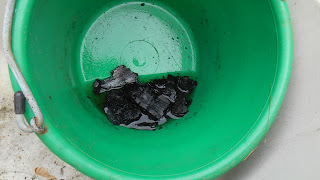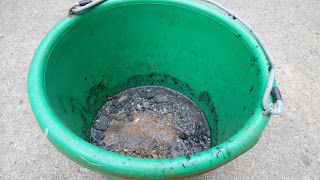Make char from organic sources Charcoal will not smell or taste at all. Pure carbon has no smell.
Moisturize char, ideal moisture level like a damp sponge.
Micronize the smaller the pieces, the larger their surface area.
Mineralize I used rock dust loess (soil particles born on the winds) & herbs.
MICROBES! Finally, sift in some finished compost.
Maturation This is the period of time it takes for the microbes to inhabit the prepared char.
Typically, I stir it at least a few times per day during warm weather, perhaps once or twice a day if it is cooler. My fastest maturation ever was about six weeks, the longest took six moons. The character of the biochar changes and the smell changes from nothing, because the carbon is absorbing all the smells, to having a rich soil like smell.
A good way to test char to see if it qualifies as biochar is to make a small box within which worms can survive, then put a cardboard barrier between the two halves, fill one with the biochar, the other with a container of worms, then remove the barrier. Let this stand overnight and see if the worms have invaded the char. If they have, it is ready to apply.
Here is the deal, this much is for free. The full class is three and a half hours and requires students to be facile with the contents of several books. Reading list upon request to tony@turnoutpac.org I charge for classes and can make a charmaster of anyone willing to learn. I am also available for consulting for people who are not sure if their systems will be effective and/or efficient.
Moisturize char, ideal moisture level like a damp sponge.
Micronize the smaller the pieces, the larger their surface area.
Mineralize I used rock dust loess (soil particles born on the winds) & herbs.
MICROBES! Finally, sift in some finished compost.
Maturation This is the period of time it takes for the microbes to inhabit the prepared char.
Typically, I stir it at least a few times per day during warm weather, perhaps once or twice a day if it is cooler. My fastest maturation ever was about six weeks, the longest took six moons. The character of the biochar changes and the smell changes from nothing, because the carbon is absorbing all the smells, to having a rich soil like smell.
A good way to test char to see if it qualifies as biochar is to make a small box within which worms can survive, then put a cardboard barrier between the two halves, fill one with the biochar, the other with a container of worms, then remove the barrier. Let this stand overnight and see if the worms have invaded the char. If they have, it is ready to apply.
Here is the deal, this much is for free. The full class is three and a half hours and requires students to be facile with the contents of several books. Reading list upon request to tony@turnoutpac.org I charge for classes and can make a charmaster of anyone willing to learn. I am also available for consulting for people who are not sure if their systems will be effective and/or efficient.






No comments:
Post a Comment